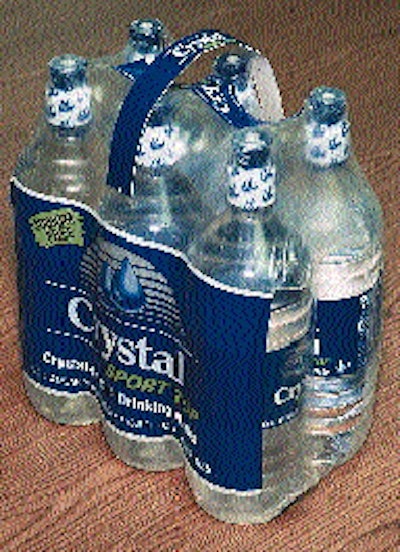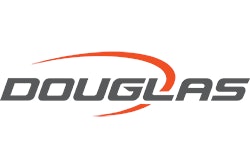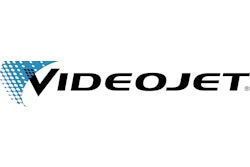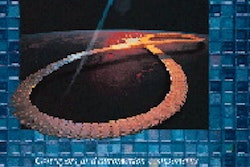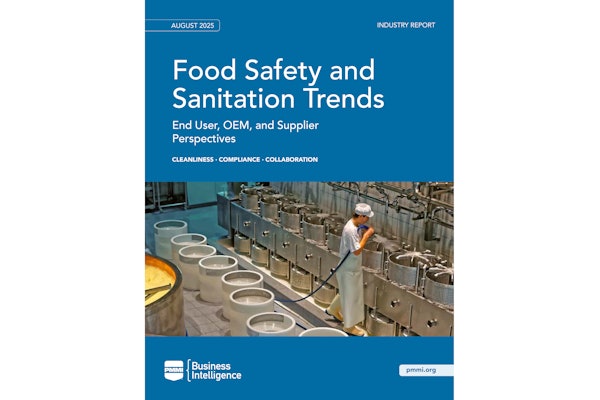Okay, so it took an eleventh-hour addition of 1귔 sq' to fit it all in. When the dust had settled and production began, McKesson Water Products Co.'s new packaging line proved to be just what management had in mind as it moved bottling from co-packers to its own Santa Ana, CA, facility. Running since February, the new line fills half, 1-, and 1.5-L bottles made of polyethylene terephthalate at speeds of 300, 240, and 200 bottles/min respectively. Just as impressive as the line's primary packaging segment (see Packaging World, December '96, p. 33) is secondary packaging. It features a shrink bundling system that cranks out unsupported six-packs in printed film applied in register. Also quite new in the U.S., though well-established in Europe and other international markets, is a handle applicator that McKesson uses to make its six-packs of 1/2- and 1-L bottles easier to carry from the supermarket. The shrink wrapping system was supplied by Douglas Machine (Alexandria, MN). McKesson's marketing managers say they prefer it over other six-pack concepts like molded plastic carriers or paperboard cartons. Printed film provides a more prominent billboard effect on store shelves than six-packs in molded plastic carriers. And the film is less costly than printed paperboard carriers. Also, combined with the carrying handle, McKesson's six-packs are convenient and differentiated, two important characteristics in today's market. "We're not the first in the U.S. to use this handle applicator, but it's not very common here yet," says McKesson's engineering manager, John Bradbard. Shrink wrapping in register Before handle application comes shrink-wrapping on the Model SR10/1224C from Douglas. The film it applies is a 2.5-mil PE blend, printed flexo in seven colors by supplier Bemis Co. (Terre Haute, IN). Unlike dual-roll systems, no heat seal bars are needed, and no welded seams are visible on the leading and trailing edges of the wrapped bundle. The machine employs Douglas's single-roll wrapping system, which meters film to a predetermined length and cuts it at an eye mark. Wrapping is accomplished as collated bottles are conveyed over the leading edge of the precut length of film. A wand then carries the film over and around the product completing the wrapping operation and creating a 2" overlap of film beneath the bottles. Thus far no heat has been applied. The next step is a transfer from the discharge conveyor to the heat tunnel conveyor, which is made of a glass fiber belting through which heated air is blown. This causes the two ends of film that are overlapped to bond tightly. All that remains is conveying through the rest of the heat tunnel, which shrinks the material down tight. When it is time to change bottle sizes, the shrink wrapper's modular metering system helps a good deal, says project engineer Bruce Potter. Rather than requiring mechanics to adjust infeed lanes, that complete section is rolled out and a new one replaces it. "It's one of the nicer things about the Douglas compared to some of the others we looked at," says Potter. The shrink wrap has a chance to cool as it's conveyed around a conveyor turn from the Douglas machine and toward the Comag Model MMEU5555 that applies the handle. Based in Italy, Comag is represented in the U.S. by Kisters (Erlanger, KY). Each lane of the dual-lane applicator has a rated speed of 55 packs/min, so it's perfectly capable of keeping up with McKesson's top filling speeds. The two components it applies to each bundled six-pack are a paper grip and a 2-mil polypropylene tape with a 0.8-mil adhesive. The paper grips and the tape are both from 3M (St. Paul, MN). Tape holds the load Fed from a 5ꯠ-m (16굴') roll, the tape is the load-bearing component. The paper provides a handle area and covers the adhesive of the tape. It also presents yet another opportunity for graphics or promotional information. The Comag receives random bundled six-packs. A series of timing conveyors having progressively faster speeds assures proper spacing through the machine. Paper grips are magazine fed. The tape runs through a series of dancer rollers and then, sticky side up, directly beneath the magazine full of grips. A small pneumatic cylinder drives the tape up to pick off the bottom grip from the magazine. Rollers make sure the paper grip is centered and secure on the tape. The tape feeds over another roller to the bundles passing below. The leading edge of the tape is held by an actuating arm that applies the tape to the leading edge of the bundle passing beneath. Next another actuating arm swings down and secures the tape to the trailing edge and also cuts the tape. In the process, it positions the tape for the next application. Currently the 1.5-L bottles are not offered in a six-pack bundle. So when this large size is in production, bottles are diverted from the Douglas and Comag machines and go directly to a Kayat (Edgewater, FL) wraparound tray/case packer. Simplicity appreciated "One thing we like about the Kayat machine is that it's simple," says Potter. "It has minimal moving parts, especially considering that it does either a tray or a case. It doesn't use a lot of arms or flap tuckers. Instead, it indexes bottles onto the flat case or tray blank and then lets the bottles help push the blank down through the necessary folding and gluing sequences." The 1.5-L bottles aren't the only size packed on the Kayat machine. Six-pack bundles of 1/2- or 1-L bottles are tray-packed on this machine, too, though Potter admits this part of the packaging operation is still being resolved. "Keeping the handles from getting caught and keeping the shrink film from grabbing onto everything it touches are more difficult than we anticipated," says Potter. The two small bottles are packed in trays while the larger 1.5-L size is packed in a full wraparound case. This makes the heavy cases more stackable in the warehouse. Both cases and trays are date coded by a Videojet (Wood Dale, IL) ink-jet system. The final piece of equipment is a tray shrink wrapper from Arpac (Schiller Park, IL). Wraparound cases, of course, merely pass through the Arpac wrapper and its tunnel on their way to the spiral conveyor that takes finished cases and trays to an overhead conveyor and, ultimately, to a remote palletizing station. "In the last year and a half, we've completely reconfigured and modernized this plant," says engineering manager Bradbard. The modernization brought automated systems to lines running a variety of bottle sizes, including 1-, 2.5-, 3- and 5-gal. But the PET line was a first for McKesson, which used to have its PET bottles filled by copackers. The savings it brings should position McKesson nicely in its western markets for years to come.
